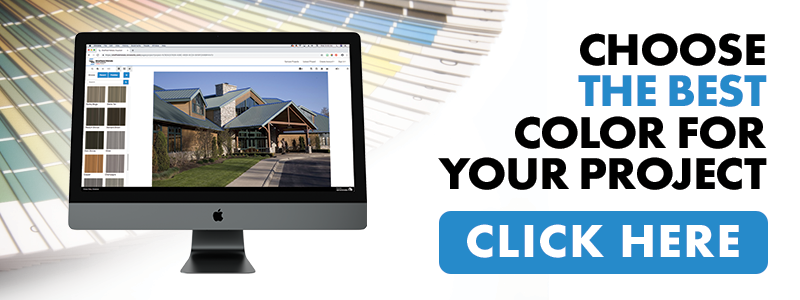Paint warranties for a newly purchased metal roof or wall system are a critical selling point in the roofing industry.
Consumers and property owners feel more comfortable purchasing a high-priority item like a metal roof when they know the manufacturer stands behind the products they sell with detailed warranties outlining what is or isn’t covered. Most companies issue finish warranties with no questions; however, consumers’ biggest concern is whether their warranty will be honored should they have a viable claim.
It’s important to understand the different elements of a warranty, including how to apply, duration of warranty, environment exclusions, etc., so an educated decision can be made.
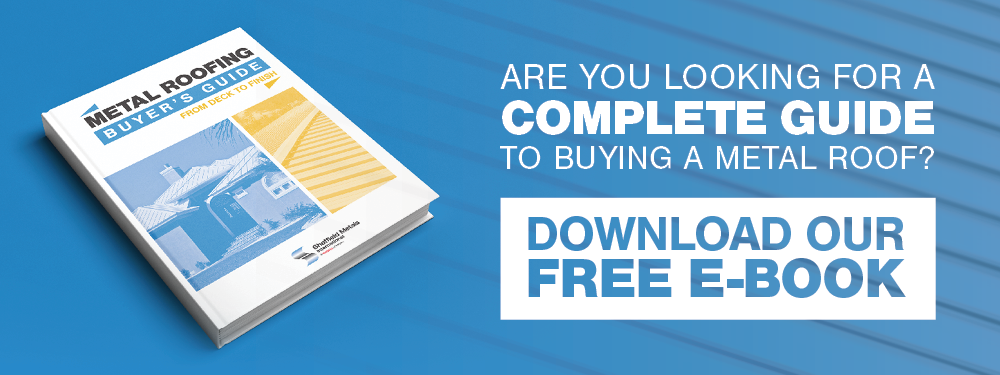
At Sheffield Metals, we understand how important warranties are to consumers, which is why we believe guiding you through the aspects of a common paint warranty will assist you during your metal roof or wall system purchase.
In this article, we’ll discuss:
- Considerations to keep in mind before buying a metal roof or wall system.
- Common aspects of a metal roof or wall system paint warranty.
- Important questions to ask before purchasing a product based on the warranty.
Factors That Can Affect a Metal Roof or Wall Paint Warranty
To ensure that you’re getting the most out of your metal roof or wall system purchase, knowing what to look for beforehand will help you make the best choice that ultimately leads to the best warranty. But the best warranty is not just what is printed on the top of the paper. You want to know the full range of exclusions and limitations so you can work with a reputable supplier that stands behind its warranties.
Paint System Type
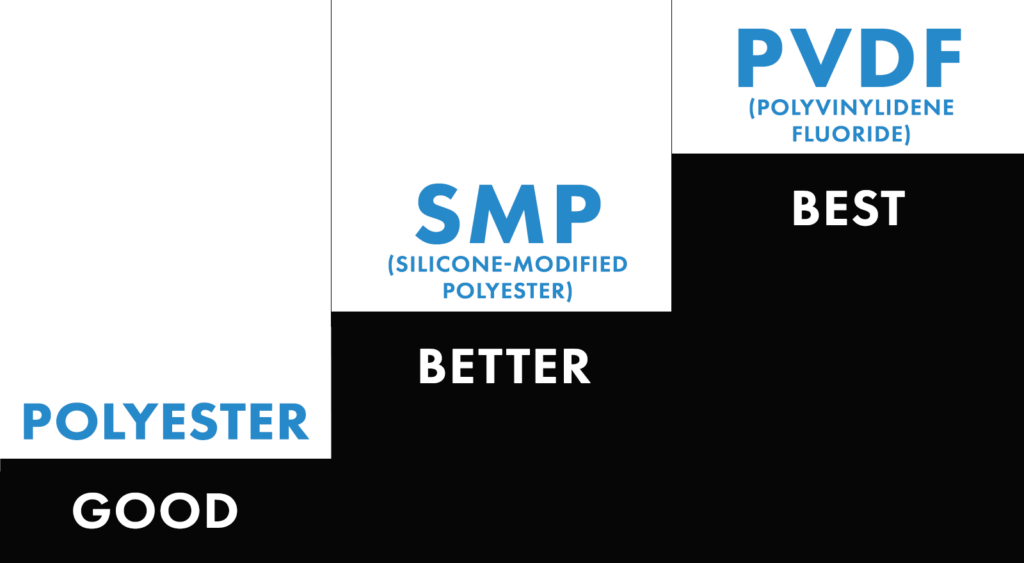
You would think that the length of the warranty depends upon the paint system’s quality. That being said, the top of a paint warranty is often considered “marketing” because it is designed to catch the consumer’s attention to say, “Look here! This is the best!” For most architectural applications polyvinylidene fluoride (PVDF) paint systems are considered the best, while silicone-modified polyester (SMP) systems are second, and plain polyester is a distant third. That being said, SMP carries a longer warranty more often than not.
You might be thinking: “How can this be? You just said PVDF is the best.” Again, it comes down to the big bold print being marketing and the fine print in the body of the warranty being the substance that needs attention.
- Depending on the manufacturer, PVDF paint warranties last 20 to 40 years for film adhesion. The chalking and fading coverage on the same warranty is generally offered for only 10 to 30 years and depends on the color.
- When it comes to SMP and the widely promoted 40-year warranty, this just applies to film adhesion. The chalk and fade coverages for these same SMP warranties are usually less than that of PVDF and have more variations in what is covered from roofs to walls.
- Polyester warranties vary dramatically depending on the quality, but they generally do not exceed 20 years for adhesion and 10 years for color.
Here’s a chart explaining the nuances using Sheffield Metals’ warranties as an example:
PVDF vs. SMP Warranty Comparison Chart
| Film adhesion length | Fading coverage length | Fading units (the lower the Hunter unit, the better the performance) | Chalking coverage length | Chalking number (the higher the chalking number, the better the performance) | |
| PVDF | 40 years | 30 years | 5 Hunter delta-E units for roofs & walls | 30 years | 8 rating on rating on roofs & walls |
| SMP | 40 years | 30 years | 7 Hunter delta-E units for roofs (horizontal) 5 Hunter delta-E units for walls (vertical) | 30 years | 6 rating on roof panels (horizontal) 8 rating on rating on walls (vertical) |
As you can see on the chart, PVDF and SMP have the same coverage lengths; however, the levels of chalking and fading are better for PVDF. You can expect less chalking and fading in the 30-year fading coverage window with PVDF.
Environment
One of the biggest questions you should have is: Is the product I’m getting warrantable in the environment in which it is being installed? For instance, steel will not be warranted within specified distances from coastal environments. So how do you get a finish warranty in coastal environments? You should consult with your manufacturer because many don’t have a standard product that will perform and be warrantable, but there are specialty paint systems that can be warranted on the coast, so it’s good to at least check. Some manufacturers will warrant painted aluminum systems in coastal environments.
Other environmental conditions can impact the ability to get a warranty that should be considered before purchasing, such as buildings that contain livestock, water treatment facilities, pools, etc. It is important to consider your environment before you install metal, and if you have a question, call your manufacturer first.
Weathering Factors
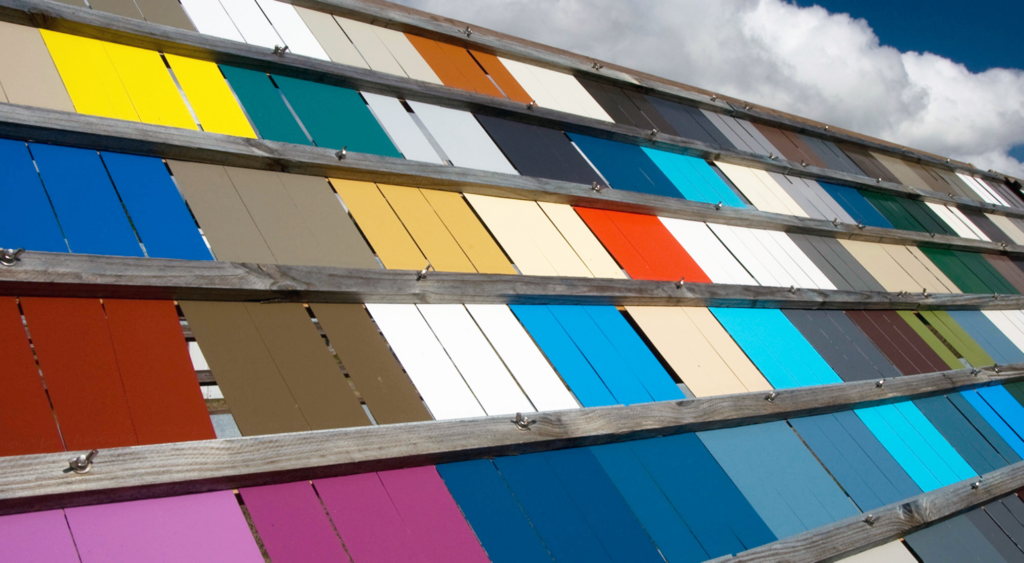
A good way to understand how your metal roof will weather is to look at it like your favorite cotton t-shirt. When you bought the shirt, it was a bright red with your favorite team’s logo in a rich blue. You wear this shirt a few times a month, and after a couple of years, you pull it out of the drier to hang it up and realize the bright red looks more like peach and the rich blue looks more like a dull green. It’s still a nice shirt that wears well, so you continue to wear it.
Some colors fade faster than others; a dark color will remain “darker” longer in Northern Ohio than in South Florida. In the t-shirt example, red will fade faster because brighter colors tend to fade faster than earth tones, which is the same concept for metal roofing and wall systems. The single biggest advantage PVDF has over SMP paint systems is that it will hold the color integrity longer (specific measurements are used to calculate chalk and fade, which you can read about in this article). The bottom line is that your metal roof or wall system will fade over time because of weathering and UV exposure, but how much will depend on the type of paint system that is used.
Type of Roofing Material
Different metal materials are often subject to different warranty time frames based on their degradation schedule and how well the metal has been tested to last in a given environment. For example, aluminum has a substrate warranty of 20 years, Galvalume-coated steel has a substrate warranty of 25.5 years, and galvanized steel that has been painted often doesn’t carry a substrate warranty at all. Knowing the lifecycles of different metal roofing materials will help you choose the best warranty for your purchase.
Company Reputation
Doing business with a trustworthy company that stands behind its products and warranties is one of the most vital attributes to consider. Do your research ahead of time by:
- Reading reviews.
- Asking your neighbors.
- Asking the business questions.
- Talking with the installers about past clients.
- Calling the business’s paint system supplier.
- Looking to see if court claims have been filed by past warranty holders.
One of the biggest deciding factors in the paint supplier we partner with is their reputation for honoring warranty claims. From the base metal to the paint supplier to the metal coater, each company is a crucial piece of the paint warranties.
Warranty Length
Often, the decision to choose a metal system boils down to the building owner deciding that this roof or wall system will be the last one they ever have to purchase. A rough idea of how long you plan to own the building or home is always a good consideration. While some circumstances are unpredictable, keep this aspect in mind just in case. However, many warranties are transferrable, meaning that if you want or need to sell the structure, it can be re-filed under the new build owner’s name for future use.
Analyzing a Metal Roof Paint Warranty
Part 1: What Does the Warranty Apply to?
This section addresses what the manufacturer will cover if a consumer has a potential claim. Pay close attention to the fine print.
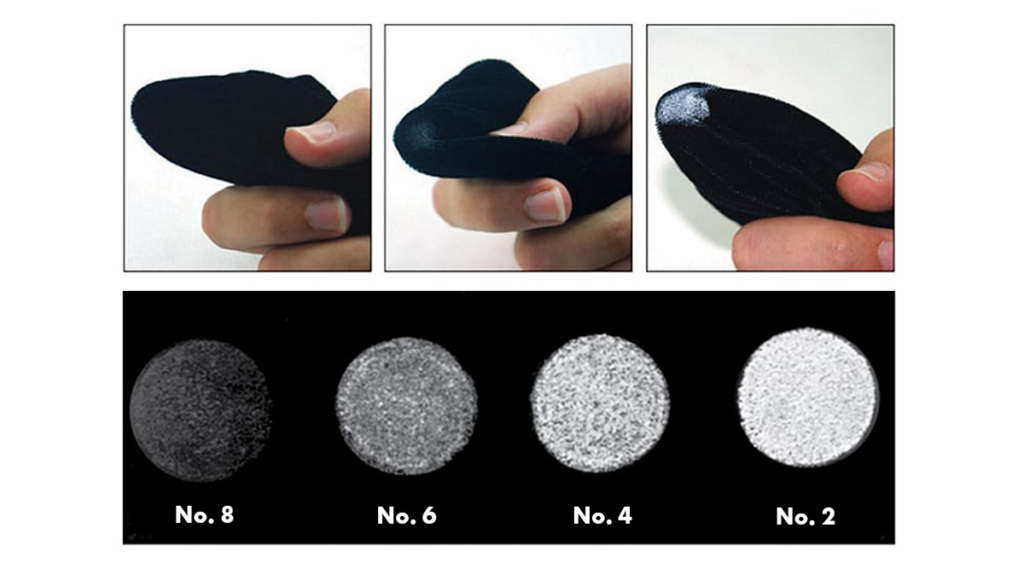
Commonly covered paint warranty items include:
- Cracking, flaking, or peeling to an extent that is visible on ordinary outdoor visual observance. This is generally the advertising portion of the warranty, so you will find this at the top and in bold. Also, keep in mind that this portion specifically refers to paint adhesion.
- Chalking is a resin system degradation and loss of adhesion on the paint’s surface that results in a white coating. The warranty ensures your metal roof or wall system will not exceed a specified number based on a particular ASTM (ASTM D-4214) method (roof and wall panels normally have different specified numbers because the roof will have significantly more UV exposure than the walls). Chalk testing measures the white chalkiness that physically transfers from the panel’s surface. Essentially, the collected measurement of chalking is how the lab can determine if it is excessive and would warrant a valid claim. For example, if you ever rubbed up against old metal siding and notice a white residue on your arm or sleeve, you’ve come into contact with chalking.
- Color fade, which occurs when the paint’s pigment breaks down and alters the color, exceeding a specified ASTM D-2244 Hunter Delta E (DE) unit. The amount of fade is determined on a number scale by comparing a sample to the baseline color. Every paint warranty should specify the amount of change in Hunter units over a certain time. Reputable manufacturers should even go as far as spelling out that it varies with some colors and does not exist with metallic colors because a color spectrophotometer (the tool used to measure color) can’t read the metallic flakes in the paint. Bottom line: Read your warranty and ask questions.
- A substrate is defined as the base metal that the actual paint is applied to. Be sure to verify that your substrate carries a warranty before you buy. Galvalume substrates normally carry a 25.5-year warranty that protects against corrosion. Galvanized steel is also a common substrate for painted metal, and you can often get a paint finish warranty with this material. Still, you likely do not have a metal substrate warranty. If you experience a paint failure due to the corrosion of a substrate that doesn’t have a warranty, options are limited and you could end up with little to no recourse.
While this analysis of common metal roof warranty sections might not cover everything a warranty encompasses, it’s still a good guide that will help answer questions and address concerns during the decision process.
Part 2: What Does the Warranty NOT Apply to?
This section outlines the circumstances that would not warrant a replacement of the metal roofing. It’s imperative to discuss any concerns you may have with the manufacturer before purchasing your metal roof or wall system. (For this example, we will reference Sheffield Metals’ 40-Year Transferable PVDF Paint Warranty.)
- Fire, deliberate damage, wind damage, or improper handling by installers.
- During the installation of your metal roof or wall system, scratches can and usually do happen. If the scratch doesn’t go down to the metal substrate, it can usually be corrected with a PVDF paint pen that uses the same paint as your roof or walls. This is something to discuss with your contractor.
- In addition to remedying scratches, paint pens can be used to touch up exposed cut edges on areas of the system. Although not required, this can help reduce the amount of edge creep over the system’s life.
- Foreign substances present in the environment and inside of the structure.
- For example, substrate warranties often do not cover steel roofing within certain distances of coastlines with breaking surf or coastlines with bay or marsh areas.
- Other environments often not covered: Locations with exposure to corrosive chemicals, ash, fumes, cement dust, copper or lead runoff, silver or nickel mining, carbon black, or treated lumber.
- After-the-fact additions to a roof that may affect the chemical makeup, like adhered solar panels, snow guards, etc.
- Consider the roof’s material and research the other materials that may cause premature degradation.
- Liquid or solid material submersion.
- Altered or sculpted beyond what it was intended for.
- Stored or installed in a way that allows for poor air circulation.
- Exposure to animals or animal waste.
- Complimentary roof products, fasteners, or penetrations that could cause a galvanic reaction and ruin the finish or corrode the metal.
- Using non-standard industry details, such as a modified J-clip or “receiver” details that will trap moisture and debris on the paint finish for extended periods of time.
Part 3: Timeframe Explanation
Keep an eye on the time frames expressed throughout a warranty, as they may change depending on the circumstances. For example, on the same exact warranty, chalking may only be covered up to 20 years, fading for 30 years, and adhesion for 40 years. This is normal in the roofing industry because some resins, colors, and paint systems are warranted differently as the materials age, which is often reflected and thoroughly explained in the warranty document.
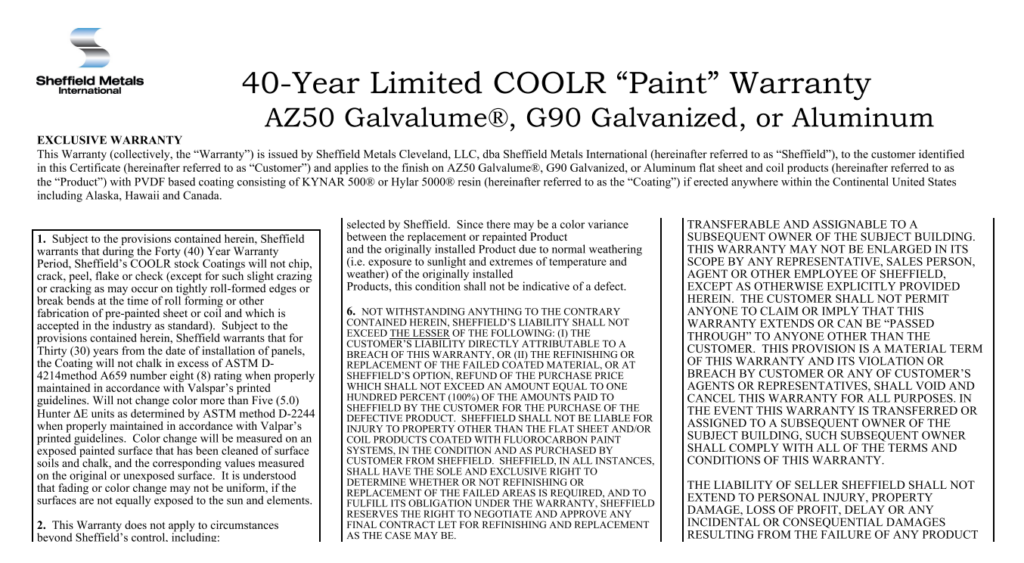
Part 4: If You Think You Have a Warranty Claim
If you experience a failure of the substrate or paint finish, a good place to start is with the manufacturer of the metal roofing system. Whether you have your warranty documents or not, the manufacturer should maintain the warranties internally and should be able to locate them within a reasonable timeframe (expect to wait a little longer if you do not have the documents).
Typically there is a clause in the warranty explaining if the manufacturer, dealer, contractor, applicator, distributor, or paint system supplier is responsible for inspecting the metal roof or wall system in question. The warranty issuer should go through the investigation process with the building owner. It should follow a process similar to:
- Notify the product manufacturer in writing during the warranty period and within 30 days of the customer becoming aware that a warranted condition has occurred. It’s also suggested to follow up with a phone call. Failure to give notice within a specified time frame could relieve the manufacturer from any warranty obligations.
- A site inspection from the manufacturer will usually occur to determine if it is a coating failure and a valid warranty claim.
- If the claim is valid, the manufacturer will file a claim with the paint system company and will work on resolving the issue on your roof, whether it’s fixing the paint system or replacing the panels.
Keep in mind: Warranty claims require all parties to remain patient, as it is the pulling together of several parties and resources to ensure a claim is valid and then handled appropriately. Learn more about the paint warranty claims process here.
Part 5: Special Cases & Exemptions
If there is a coil type, special color, material, or other exemption that does or does not apply to the warranty, it should be explicitly stated in the warranty contract. Custom colors and substrates have special warranties specific to that particular product, environment, or application. For instance, if you are in a coastal condition, get a product (usually aluminum) that meets those specifications. Or if you are requiring a custom color, make sure you are aware of the limitations of custom colors (per the manufacturer).
Part 6: Additional Legal Statements
This is typical legal speak stating who is or isn’t liable for certain situations, disclaimers, safety liabilities, financial statements, etc. If you don’t understand this section, ask questions, ask a lawyer specializing in contracts, or find a different product with a company you know will explain and stand behind their warranty.
Part 7: Signature & Verification
The most important part of a warranty is the consumer’s signature. Until the warranty copy is signed and in possession of the warranty supplier, it does not hold any value or worth. Always ensure that the company offering the warranty received a copy of the signed document to keep for their records in case an issue or warranty claim occurs.
Questions to Ask the Metal Roof Manufacturer
As a consumer, asking the salesperson or representative at the manufacturer difficult or complex questions is recommended and expected. Purchasing a metal roof or wall system is a large expense, so make sure you do your due diligence by asking these questions:
- What is covered by this warranty?
- What is not covered by this warranty?
- Are there any special conditions or limitations that do or don’t apply to the warranty?
- Do I need to re-enroll or have inspections done during the warranty?
- Is there anything I can do to help maintain the condition of the roof?
- Who do I need to contact if I need to use the warranty?
- Will there be any fees associated with the warranty?
- Will you replace the product or provide a refund for the roof covered by warranty?
- Where do I request a warranty?
- Is this warranty transferrable?
- Do you have a cleaning and maintenance guide?
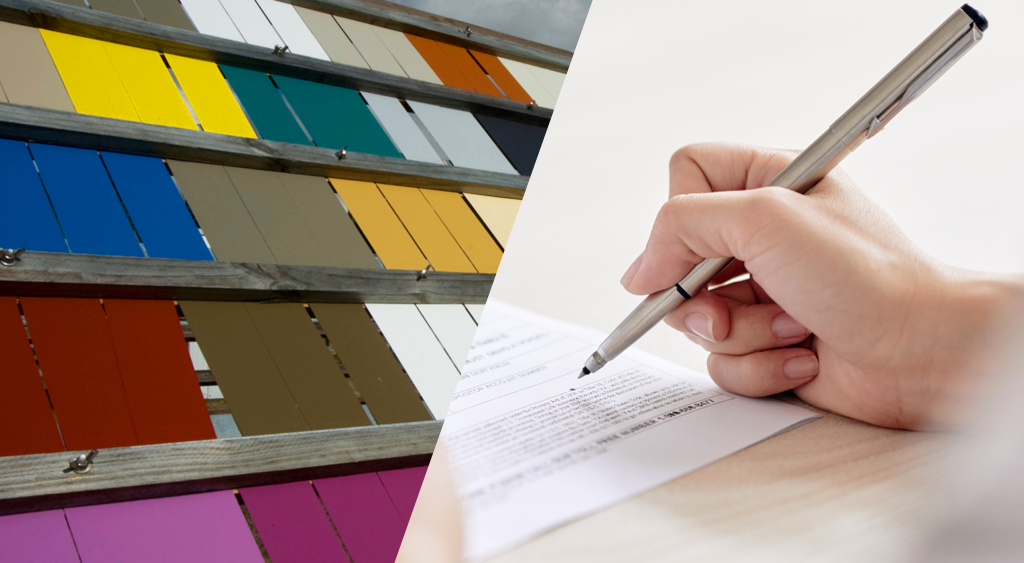
Final Thoughts on Metal Roofing Paint Warranties
Choosing a metal roof or wall system with a warranty is a great choice that will protect your investment and keep your structure safe and looking great for many years to come. It’s important to do your research, ask questions, and review the warranty thoroughly before you buy. And don’t forget:
- Have an open conversation with the manufacturer to determine their reputation.
- Ensure your warranty request is submitted to the manufacturer promptly and follow up if you have not received confirmation within 45 days.
- Save your receipt and keep it in a safe place with the warranty.
- Follow the instructions provided by the manufacturer to ensure your warranty doesn’t get voided.
- If you notice any questionable degradation on the roofing, don’t risk your safety or try to fix it yourself.
- When in doubt, call the manufacturer or contractor you filed the warranty with and ask directly.
At Sheffield Metals, we care about protecting you and your home, which is why we work diligently to provide the best paint warranty options to fit the interests of all consumers.
To learn more about the paint warranties on the coil products we offer to our customers, contact us to talk to one of our metal roofing or wall system specialists today.
